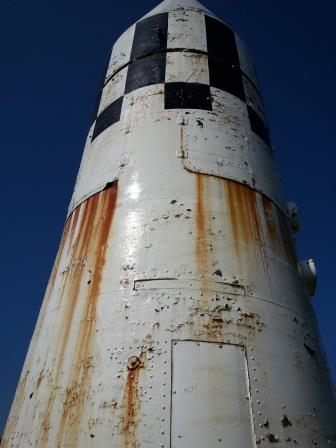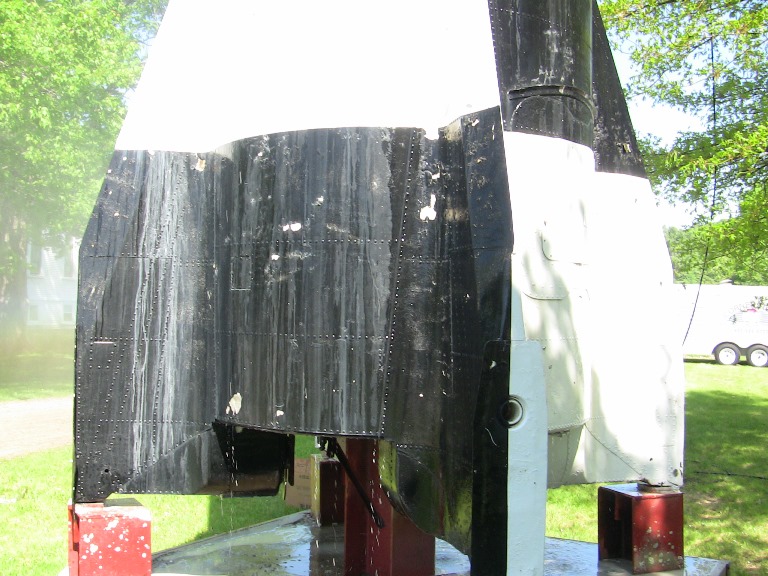At 112 Water Street in Warren, N.H., stands a 70-foot-tall (21 m) piece of history. The Redstone Rocket is hard to miss, especially for this town that’s home to a mere 900 people. It’s “a local landmark…you mention the town and the first thing that you know is the rocket ship,” according to Richard Rogers. Rogers, president of Cornerstone Painting Contractors, headed the two-person recoating of the 1,268-square-foot (118 m²) historic project that transpired this past summer.
The 64-year-old missile, which is the sister rocket to the one that sent Alan Shepard (also a New Hampshire native) up into space, needed a major facelift. And Cornerstone had two weeks to do it before the town’s annual tour of local houses, called Old Home Day. Could they make the short journey a successful one?
Project Liftoff
On June 3rd, the coatings crew started work on the aluminum rocket. Using the company’s 60-foot (18 m) Terex boom lift and a rented JLG 80-foot (24 m) boom lift, they began by prepping the substrate. Although they would have preferred abrasive to prepare the rocket, they used power washers and angle grinders instead. This decision was due to directives from the city, something Rogers believed was due to funding. “It would have cost an additional [amount],” Rogers explained. “I would have guessed it would have been in the $10,000 range.”
Although $10k isn’t necessarily a large chunk of change for many construction contracting crews, Rogers knew that it would have been significant to the town. So he accommodated the client. Luckily, the surface prep was sufficient to get the surface cleaned; they weren’t aiming to get the aluminum to a bare metal surface.
 The crew “pressure-washed [the rocket] to get all the loose paint and mold/mildew off,” Rogers explained, and used a 4.5-inch (11 cm) ceramic flap disk angle grinder to work any areas that still showed stubborn pieces of paint. It took the crew about 10 man days to “ground a full rocket top to bottom,” in Rogers’ words. “Then we went back up. Obviously we’re getting 90 percent off the first time (trying for 100 percent). We went back up to the top and reground again just to get anything that was missed or was loose.” They hit the rocket one more time with a power washer to rinse off any of the debris left behind from the grinding.
The crew “pressure-washed [the rocket] to get all the loose paint and mold/mildew off,” Rogers explained, and used a 4.5-inch (11 cm) ceramic flap disk angle grinder to work any areas that still showed stubborn pieces of paint. It took the crew about 10 man days to “ground a full rocket top to bottom,” in Rogers’ words. “Then we went back up. Obviously we’re getting 90 percent off the first time (trying for 100 percent). We went back up to the top and reground again just to get anything that was missed or was loose.” They hit the rocket one more time with a power washer to rinse off any of the debris left behind from the grinding.
“I guaranteed that we’d prep this best that could be,” explained Rogers. As most seasoned coatings professionals know, he’ll tell you that just like any other coatings job, “all the work was in the preparation.” For this job, that included one final step before applying the coatings. “There were some holes near the bottom just from vandalism over the years that we bonded to clean it up and make it more presentable.” And then, after waiting 48 hours for the substrate to dry, the crew was finally ready to start painting.
Warren, we have liftoff!
Zero Gravity…Not
Because almost the entire project was done at height, that meant the crew needed to wear special safety gear throughout the job. Each person wore safety harnesses along with respirators, safety glasses, and a protective shield. But working at height did not mean that the crew had to worry about boots on the ground…especially considering the lack of foot traffic in Warren in general.
So they didn’t need to worry about protecting pedestrians from debris, but they did need to ensure that everything within their radius was protected from potential overspray. Their solution? Use rollers instead. “Being 70 feet [21 m] in the air and spraying aliphatic, which could go a long way before it dries, we figured this would be the safest route,” Rogers explained. “And in the end it was pretty quick; we could coat it in one day with rolling it.”
Roll with it is exactly what the Cornerstone Painting crew did on this job. They applied Insl-x’s Corotech Epoxy Pre-Primer V155 with a 1/4-inch (6 mm) nap. They rolled on the 100 percent solid primer, which was clear, at 1,500 square feet per gallon (139 m²/L). “It’s more of a rust-encapsulating primer,” Rogers explained. They let that layer cure for 24 hours before coming in to apply two layers of the white topcoat, Corotech Aliphatic Urethane/SG V-510. Each layer of the aliphatic urethane semi-gloss topcoat was applied with a 3/8ths inch (10 mm) nap at an average 2 mils (51 microns) per coat.
 Luckily, they didn’t have much external matter to defend against. Not even the weather could blitz their forward march. Most days, the crew experienced the typical 80° F (27° C) weather. On days when the atmosphere didn’t cooperate, the crew just made sure to pay very close attention — to the weather and the pot life.
Luckily, they didn’t have much external matter to defend against. Not even the weather could blitz their forward march. Most days, the crew experienced the typical 80° F (27° C) weather. On days when the atmosphere didn’t cooperate, the crew just made sure to pay very close attention — to the weather and the pot life.
Oncoming storms had the potential to throw a wrench in the crew’s work. It wouldn’t affect the solvent-based coating already applied to the rocket, but it could have affected coating not yet applied. “This product had basically a three-hour pot life. Because of temperatures we were dealing with, we kind of had to work this rocket ship down in segments,” said Rogers. The crew worked each coat from the top of the rocket down to the bottom around the circumference. “We’d bring it down to a certain point, and know that we were getting to the end of our pot life, and stop at that point and mix up another batch.” It was a lot of logistics to consider.
And with a two-hour ride from the crew’s shop in Hooksett, N.H., the Cornerstone crew didn’t want to waste time, money, or product. “We just checked the forecast first,” said Rogers of his plan to mitigate weather-related issues. “It just prolonged the project a little longer than if we had clear days.” But they still hit their target end date!
Touchdown!
For the finishing touches, the crew needed to do two things: paint the black checker pattern near the top of the rocket and paint the four I-beams that supported the missile. They used reference points before they put on the white topcoat so that they’d know where the black urethane coating went. As for the 8-foot (2 m) I-beams, they painted those gray using oil-based industrial enamel. They finished it off by hiring a company to attach the vinyl “USA” lettering and then called it a day.
For Rogers, who remembers riding his snowmobile in his younger days on the state trail that runs next to the rocket, this job was special. “I think that the uniqueness of it is what’s interesting,” Rogers said. “You know, there’s a whole history behind it.” It wasn’t a difficult project overall, but the rocket showcases a history that has a personal connection to Rogers as well as many other Americans.
Roller coasters down the road might be more exciting to passersby, but the Redstone Rocket job was unique. Besides, just as Rogers said, “if you’ve got the correct way of approaching it, complicated jobs become easier.”
